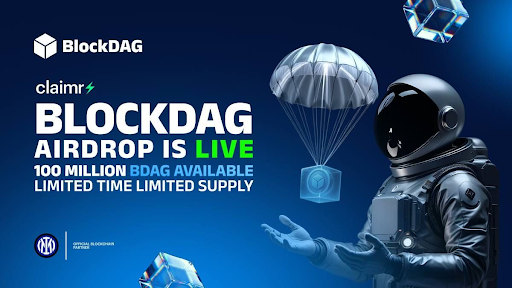
Disclosure: This article does not represent investment advice. The content and materials featured on this page are for educational purposes only.
BlockDAG’s 100m token airdrop goes beyond hype. With real tools, testnet activity, and community mining live, here’s why BDAG stands out in today’s crowded crypto market.
If there’s one phrase that gets thrown around too loosely in crypto, it’s “best crypto to buy now.” But in BlockDAG’s case, the facts speak louder than the headline. As the project rolls out a 100 million token airdrop campaign, it’s doing more than just incentivizing clicks, it’s laying the groundwork for a decentralized ecosystem before its token even hits exchanges.
Unlike most Layer 1 presales filled with speculation and vaporware promises, BlockDAG has gone operational before launch. A live testnet, a functional no-code smart contract builder, 2 million+ users mining through the X1 app, and over 18,000 ASIC miners sold, all while tokens remain non-circulating. This is infrastructure in motion, not whitepaper theater.

The Airdrop isn’t just marketing, it’s strategic onboarding
The 100M BDAG airdrop is structured around tasks that benefit the ecosystem:
- Testnet quests help refine system performance before mainnet launch.
- Presale quests tie directly into buyer incentives, including hardware integration and referrals.
- Social quests expand authentic reach, not just impressions.
- Referral quests bring in active participants via peer networks.
This structure ensures users aren’t just spectators, they’re contributors. Each task is a touchpoint with live infrastructure, not hypothetical tools. That’s rare, especially at the presale stage. While the airdrop is active, so is the presale. BDAG’s current special price of $0.0020, compared to its confirmed listing price of $0.05, offers an ROI window of over 1,567%.
More importantly, the demand-side pressure is already building:
- 23 billion coins sold
- $315m+ raised
- Nearly 200,000 BDAG holders
- Presale price increase coming soon
This convergence of milestones creates a classic supply vs. demand asymmetry, buyers are lining up before tokens even hit exchanges.
Airdrop meets ecosystem: Compounding utility
Most crypto airdrops end when the campaign does. BlockDAG’s continues through its utility.
- Users testing the no-code dApp builder may go on to deploy live apps after mainnet.
- Miners earning BDAG now will be the first to profit when liquidity hits.
- Community-run nodes, launching before listing, will shape the early governance layer.
These aren’t short-term plays. They’re entry points into a Layer 1 that’s already onboarding participants through live infrastructure.
Why this airdrop means more than just free tokens
The biggest problem with airdrops today? They’re often detached from value. Airdrops for chains that haven’t shipped. Campaigns where bots dominate. Rewards that vanish post-listing.
BlockDAG flips the model:
- Tools are live.
- The testnet is being used.
- The miner network is growing.
- The community is shaping protocol mechanics before token price discovery.

The airdrop, then, is not a sideshow. It’s a catalyst, for engagement, for testing, and ultimately, for early user rewards that reflect real participation.
Why BDAG is the leading crypto to buy now
When you strip away the noise, a good crypto buy comes down to one thing: utility before hype. BlockDAG is proving that it’s possible to deliver structure, tools, and participation at scale, all before the first token trade.
The $0.0020 price won’t last long. Nor will the opportunity to be early in a system where user engagement, not VC backing, drives value.
If users are looking for the best crypto to buy now, they’re not just looking for gains; they are looking for projects that earn attention by building. BlockDAG, with its multi-purpose airdrop, active testnet, and dual mining ecosystem, is doing exactly that.
To learn more about BlockDAG, visit its presale website, Telegram, and Discord.
Disclosure: This content is provided by a third party. crypto.news does not endorse any product mentioned on this page. Users must do their own research before taking any actions related to the company.

Source link

